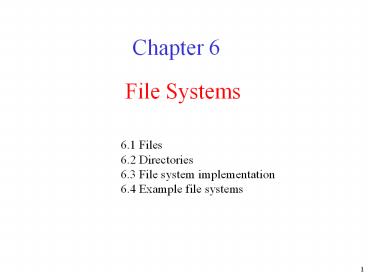File%20Systems - PowerPoint PPT Presentation
Title:
File%20Systems
Description:
Directories: system files to maintain system's structure ... User (or process) specifies a directory as current and all paths (not beginning ... – PowerPoint PPT presentation
Number of Views:27
Avg rating:3.0/5.0
Title: File%20Systems
1
File Systems
- Chapter 6
6.1 Files 6.2 Directories 6.3 File system
implementation 6.4 Example file systems
2
Long-term Information Storage
- Must store large amounts of data (virtual address
space may not be big enough) - Information stored must survive the termina-tion
of the process using it, or if the computer
crashes - Multiple processes must be able to access the
information concurrently - Files are managed by the OS. Structure,
management, naming, accessing, etc, are part of
the file system.
3
File Naming
- Characters, digits, special characters
- Lower case and upper case letters
- File extensions (e.g. prog.c, prog.c.Z)
- Unix extensions mean nothing, however certain
programs may require specific extensions - Windows aware of extensions assigns meaning.
Programs own extensions.
4
File Naming
- Typical file extensions.
5
File Structure
- Three kinds of files
- byte sequence no meaning for OS, meaning at
user level - record sequence fixed length, structure (e.g.
card images) - tree each has a key field, tree is sorted on
that key
6
File Types
- Regular files the ones that contain user
information - Directories system files to maintain systems
structure - Unix Character and Block special files
- Regular files
- ASCII (plain text)
- binary (internal structure)
- Every OS must at least recognize its own
executable file
7
File Types
- (a) An executable file (b) An archive
8
File Access
- Sequential access
- read all bytes/records from the beginning
- cannot jump around, could rewind or back up
- convenient when medium was magnetic tape
- Random access
- bytes/records read in any order
- essential for data base systems
- read can be done in 2 ways
- give the position in the file and initiate a read
- move file marker (seek) to set current position
and then read
9
File Attributes
- Possible file attributes
10
File Operations
- Create
- Delete
- Open
- Close
- Read
- Write
- Append
- Seek
- Get attributes
- Set Attributes
- Rename
11
An Example Program Using File System Calls (1/2)
12
An Example Program Using File System Calls (2/2)
13
Memory-Mapped Files
- Motivation access files in a uniform way
- Segmented process before mapping files into its
address space - Process after mapping
- existing file abc into one segment
- creating new segment for xyz
- Problems the usual ones
14
DirectoriesSingle-Level Directory Systems
- A single level directory system
- contains 4 files
- owned by 3 different people, A, B, and C
- Potential problem same filenames
15
Two-level Directory Systems
- Each user gets a private directory letters
indicate owners of the directories and files - When a user tries to open a file, system knows
which user is - Users may want to access files in other users
directories
16
Hierarchical Directory Systems
- A hierarchical directory system
17
Path Names
- If file system is a directory tree gt naming
scheme? - Two methods to specify file names
- absolute paths path from root to file (e.g.
/usr/ast/mailbox) - relative paths used in conjunction with the
working or current directory. User (or process)
specifies a directory as current and all paths
(not beginning with the separator) are taken
relative to that (e.g. ast/mailbox, if current
/usr/) - Each process has its own working directory
- Library procedures rarely change the working
directory - . (dot) and .. (dotdot) directories current and
parent directories
18
Path Names
- A UNIX directory tree
19
Directory Operations
- Readdir
- Rename
- Link
- Unlink
- Create
- Delete
- Opendir
- Closedir































